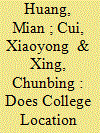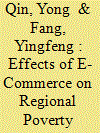|
|
|
Sort Order |
|
|
|
Items / Page
|
|
|
|
|
|
|
| Srl | Item |
| 1 |
ID:
186223


|
|
|
|
|
| Summary/Abstract |
Based on a representative survey of new college graduates in China, we present a job location choice model that allows for a self-selection effect in college regions by considering region-dependent heterogeneous preference for job locations and unobservable location features. We also treat endogenous housing costs using the method developed by Berry et al. (1995). Our estimation results show that college education significantly increases graduates' likelihood of working in the city where their college is located. However, a model that does not consider the self-selection effect overestimates this impact. The impact of college location on a graduate's migration decision varies considerably across cities. There is significant heterogeneity between students from universities of different tiers and rural versus urban areas. Meanwhile, the graduates show a marked home preference when choosing their job locations, and they tend to avoid working in cities with high housing costs. These findings shed light on debates on place-based higher education policies and spatial distribution of human capital with a high level of education.
|
|
|
|
|
|
|
|
|
|
|
|
|
|
|
|
| 2 |
ID:
186222


|
|
|
|
|
| Summary/Abstract |
Information and communication technology plays an important role in human life and social production. The existing literature has mainly studied the economic impact of such technology in developed countries; the use of broadband in developing countries has been overlooked. This paper fills the gap by examining a broadband development program in China. Difference-in-difference estimates show that the deployment of high-quality broadband promoted regional employment in the skilled service sector. The effect was larger in cities with a greater number of educated residents and cities in the west of China. We also found that broadband development stimulated firm creation and innovation. These findings imply that broadband promotes innovation and provides new impetus to the economic transition of emerging markets.
|
|
|
|
|
|
|
|
|
|
|
|
|
|
|
|
| 3 |
ID:
186224


|
|
|
|
|
| Summary/Abstract |
This paper uses the Rural E-Commerce Demonstration County (REDC) policy to estimate the effect of e-commerce on poverty reduction. We discover that the REDC policy enhanced the gross regional product per capita by 8.4 percent for the total sample of counties and 10.5 percent for a subsample of poor counties. Specifically, the REDC policy increased the aggregate final product in primary industry by 10.6 percent. The final product per capita in the secondary and service sectors was 13.1 percent and 3.3 percent higher in the REDCs than in other counties, respectively. The effects were even greater for the subsample of poor counties. The estimates demonstrate that e-commerce developed quickly in the REDCs since the implementation of the REDC policy. The income of those involved in e-commerce increased, yielding more aggregate savings deposits. The expansion of e-commerce induced more investment, suggesting that more aggregate loans are being made in REDCs. This evidence suggests new opportunities for poor people in the new digital economy.
|
|
|
|
|
|
|
|
|
|
|
|
|
|
|
|
| 4 |
ID:
186225


|
|
|
|
|
| Summary/Abstract |
Using Chinese microdata from 2000 to 2013, we document how demand shocks in export markets lead multi-product exporters to adjust markups across products. We find that, in response to positive demand shocks, quality-based competitive multi-product firms increase product markups significantly, particularly for core products, whereas cost-based competitive multi-product firms respond by reducing product markups. The reason for this is that positive foreign demand affects markups through two opposite channels: pro-innovative effects and pro-competitive effects. Pro-innovative effects are predominant among quality-based competitive multi-product firms, and these firms respond to positive foreign demand shocks by increasing product quality, prices, and markups. Pro-competitive effects are predominant among cost-based competitive multi-product firms, and these firms respond to positive foreign demand shocks by lowering product cost, prices, and markups. We demonstrate the presence of these mechanisms empirically. The results imply that firms with different competition strategies should adopt different measures in response to foreign demand shocks.
|
|
|
|
|
|
|
|
|
|
|
|
|
|
|
|
| 5 |
ID:
186226


|
|
|
|
|
| Summary/Abstract |
By applying stochastic frontier analysis, and replacing total export with value added in exports as a more accurate measure of domestic content embodied in exports, we estimate the trade efficiency between China and EU countries and analyze the determinant factors. The results show that the value added in trade between China and EU countries is running at a low level of efficiency, and the trade efficiency has an obvious imbalance between export and import. Our calculation of unexplored trade potential indicates that western EU countries, such as France, Germany, Italy, and Spain together are China's top trading partner with the highest unexploited trade potential. Based on the principal component analysis of 14 trading-related variables, trade efficiency determinant results show that the tangible trade infrastructures of both exporter and importer matters most, including airports, container shipping, Internet, and broadband infrastructures. Meanwhile, intangible trade infrastructures, including customs procedures and domestic business environments, has a significant, but smaller influence on trade efficiency. Our important findings shed light on practical trade policymaking to encourage Sino-EU trade collaboration.
|
|
|
|
|
|
|
|
|
|
|
|
|
|
|
|
| 6 |
ID:
186221


|
|
|
|
|
| Summary/Abstract |
This paper explores determinants of price premiums between A-share and American depositary receipts (ADR) or H-share and sheds light on policies using daily data from cross-listed companies from 2002–2020. Market sentiment and financial openness are critical in explaining both types of price premiums. Expected exchange rate changes significantly impact the A-share versus ADR premium but liquidity is essential for the A-share versus H-share premium. The introduction of Shanghai–Hong Kong Stock Connect in November 2014 has effectively increased the price discovery capacity of the A-share market, and investors were more adaptive to the RMB foreign exchange rate volatility after Chinese exchange rate system reform in 2015. The paper provides insights into future capital market reform in China.
|
|
|
|
|
|
|
|
|
|
|
|
|
|
|
|
| 7 |
ID:
186218


|
|
|
|
|
| Summary/Abstract |
To identify the macroeconomic environment that has enabled China's industrial upgrading during a period of persistent renminbi appreciation, we construct a two-country New Keynesian model of industrial upgrading with a global production network, endogenous firm entry, and a directed quality frontier. We show that renminbi appreciation promotes industrial upgrading without hurting real economic growth in the longer run. This holds true especially through four channels. First, the quality threshold for firm entry is lower to allow for more firms participation and thus greater product varieties (quality threshold channel). Second, upstream skill-based production uses more imported inputs of higher quality (imported input channel). Third, there is substantial global demand towards the exports of high-quality inputs (global demand channel). Fourth, domestic inputs are competing against imported inputs to broaden the scope for competition in the upstream product market to incentivize quality upgrading (scope for competition channel).
|
|
|
|
|
|
|
|
|
|
|
|
|
|
|
|
| 8 |
ID:
186220


|
|
|
|
|
| Summary/Abstract |
We explore how China's geographically targeted policies impact RMB overseas use individually or in combination. The policies include swap agreements, clearing banks, investment quotas, and direct trading between Chinese renminbi (RMB) and non-USD currencies. Adopting a fuzzy-set qualitative comparative analysis and using Bank of International Settlements cross-country data on foreign exchange markets, we find that institution building has lowered the barriers to international adoption of the RMB. Specifically, for countries economically close to China, high RMB trading is explained by either (i) having a clearing bank in the host market and direct quotations between the RMB and the local currency, or (ii) being a financial center and having access to the Chinese capital market. This combination of policies is explained by the creation of (i) “trading posts” that provide RMB liquidity abroad, and (ii) channels that allow actors to “recycle” offshore RMB funds. We triangulate our results with interviews conducted with senior People's Bank of China officials.
|
|
|
|
|
|
|
|
|
|
|
|
|
|
|
|
| 9 |
ID:
186219


|
|
|
|
|
| Summary/Abstract |
The sanctions imposed by the G10 countries on financial institutions in Russia, including on its central bank, will come under scrutiny by emerging market central banks. This will help them build appropriate safeguards against disruptions to cross-border transactions and revise their investment mandates to reduce the risk of reserve asset freezes. Building new financial market infrastructure and cross-border payment systems, or strengthening existing ones, will become the priority of emerging global powers. The goal will be to build systems that support democratic governance mechanisms, have oversight arrangements involving the central banks of trusted countries, and promote fair and safe access to clearing and settlement under well-defined policy guidelines. The use of alternatives to the US dollar as the invoicing currency in international trade will gather momentum. Markets for energy and other commodities will be the change drivers. China has an important role to play.
|
|
|
|
|
|
|
|
|
|
|
|
|
|
|
|
|
|
|
|
|